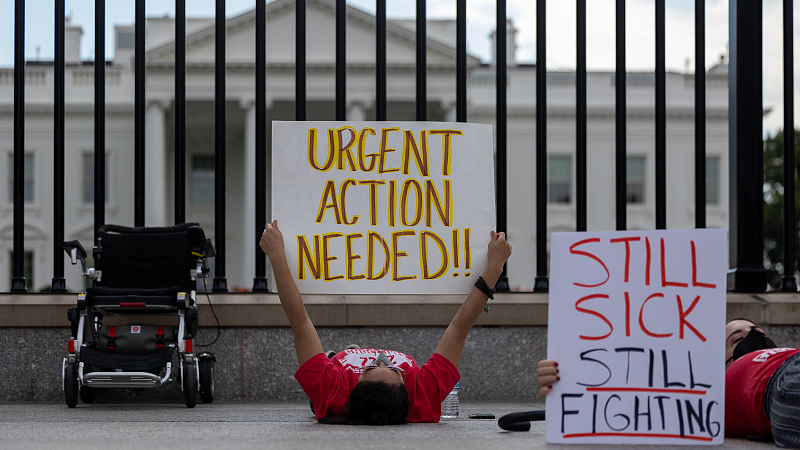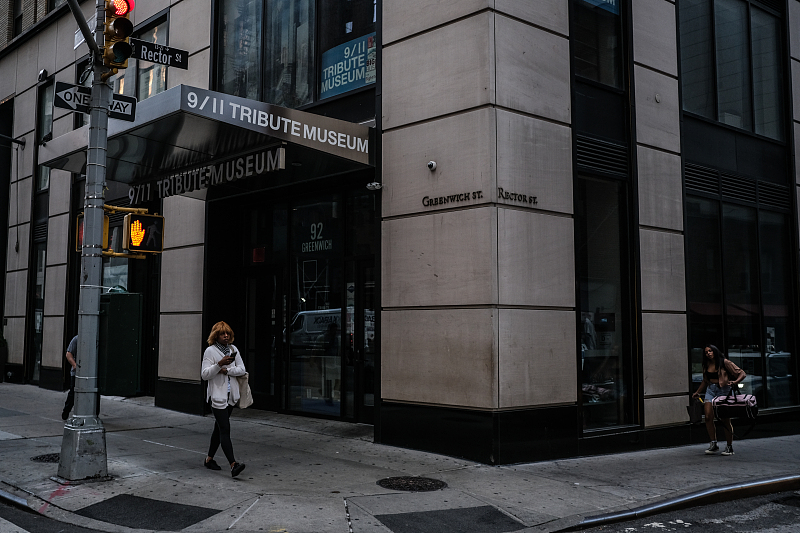
People held signs during a protest outside the White House in Washington, D.C. to oppose U.S. President Joe Biden's statement that "the COVID-19 pandemic is over in America," September 19, 2022. /CFP
People held signs during a protest outside the White House in Washington, D.C. to oppose U.S. President Joe Biden's statement that "the COVID-19 pandemic is over in America," September 19, 2022. /CFP
Editor's note: Anthony Moretti is an associate professor in the Department of Communication and Organizational Leadership at Robert Morris University. The article reflects the author's opinions and not necessarily those of CGTN.
In the United States right now, it seems everyone has either had COVID-19 or knows someone who has had it. Yes, we should be thankful that the overwhelming number of cases ended within a few days of diagnosis and with no lasting side effects.
But that is not good enough.
Sadly, there remain dark clouds on the horizon. The case count remains stubbornly high. More ominously, long-lasting health effects or death cannot be ignored. And let us not forget that as fall begins in the U.S., a likely bad flu season is projected; one U.S. news organization went so far to suggest that "influenza appears poised to stage a comeback this year in the U.S., threatening to cause a long-feared 'twindemic,'" in which flu and COVID-19 cases rise alongside each other and put significant strain on America's health care workers and the medical system.
Let's begin by looking at the big picture: According to recent data from the Centers for Disease Control and Prevention (CDC), almost 96 million Americans, or roughly 30 percent of the entire population, have been diagnosed with COVID-19. Roughly 1.05 million of those cases ended in deaths. I mention these data to validate a point: No other country in the world comes close to caseload and death toll; and that means the United States, which prides itself on its exceptionalism, is the undisputed global leader in infections and deaths.
There is another subset of COVID-19 sufferers who cannot be forgotten: long-COVID victims. A recent study examined that phenomenon, and the results should frighten us all. According to medRxiv, roughly 7 percent of survey respondents throughout the U.S. affirmed they had long-COVID, which the CDC defines as "conditions [that] can last weeks, months, or longer."
Digging deeper into the medRxiv results, which are still to be peer reviewed, 25 percent of respondents suggested long-COVID affected their daily life "a lot," and many of them reported they were diagnosed with COVID-19 roughly, if not more than, one year ago.
The researchers concluded that women, people with underlying health conditions, and people who had not received a COVID-19 booster shot or who had never been vaccinated were more likely to experience long-COVID. Remember, more likely does not mean guaranteed.
An incomplete list of the side effects of long-COVID includes exhaustion, cognitive issues and chronic pain.
Of course, the problem is not limited to the U.S. As just one example, in the United Kingdom, members of a COVID-19 committee recently wrote a letter to the nation's new secretary for health and social care. In that communication, the members offered this shocking statement: "One startling statistic is that more than 2 percent of 35-49 year olds in the UK have had long-COVID for more than a year: equivalent to around 266,000 people out of a total of nearly 900,000 in their prime working years with long-COVID."
Returning to the U.S., there are questions that demand answers: Why does COVID-19 remain a problem almost 31 months after the first cases were discovered in the U.S.? How can this nation of "exceptionalism" not find a path to solve the crisis?
Sure, the federal government is an easy target, and, yes, some of the blame does reside in Washington. Former U.S. President Donald Trump poisoned the well beginning in the spring of 2020 when he began saying that COVID-19 was nothing more than a version of the flu. He resisted calls from the medical community to use the government's power to address the developing crisis because he seemed far more interested in blaming China for causing it.

The 9/11 Tribute Museum has announced its closure due to financial woes stemming from a lack of visitors during the COVID-19 pandemic, August 18, 2022. /CFP
The 9/11 Tribute Museum has announced its closure due to financial woes stemming from a lack of visitors during the COVID-19 pandemic, August 18, 2022. /CFP
The president's dangerous rhetoric gained traction in many parts of the country, and it soon was picked up by Republican governors in multiple states. They were eager to curry favor with the man whom they hoped would be reelected that fall. As a result, they saw no reason to support calls to temporarily move education to an online environment or to promote vaccinations. They also went along with unconscionable claims at the grassroots level that the government had no right to impinge on "my freedom."
While it is true that Trump's successor has urged Americans to remain vigilant about COVID-19, we must not forget that U.S. President Joe Biden told a news interviewer about a week ago that COVID-19 was "over." At least one medical doctor was not impressed; he reminded the New York Times that the virus is still the fourth-highest cause of death in the U.S.
The average Joe and Josephine American must be held accountable for the carnage as well. In general, these groups fall into one of two populations: They either never believed COVID-19 was a problem to begin with (the aforementioned "my freedom" people highlighted above), or they now believe they are immune from the worst of the virus because they have been fully vaccinated. In effect, the former group is guilty of ignorance and the latter group is guilty of arrogance.
These groups – and they make up a large percentage of the American population – have left COVID-19 behind; they either never stopped running their lives as they had always run them, or they now want to catch up on all those seemingly precious things they were unable to do for a year or more.
Lastly, we cannot forget the role that almost all the mainstream media have played. They have reported the ins and outs of the virus, but they continue to suggest policies adopted by other nations to control COVID-19 spread are radical or inhumane.
Of course, China and its zero-COVID stance is the most prominent example. Inexplicably, these news organizations want their audiences to believe that being the global leader in infections and deaths is somehow better than any other alternative, including lockdowns.
More than one-million dead Americans might disagree, if they could.
(If you want to contribute and have specific expertise, please contact us at opinions@cgtn.com. Follow @thouse_opinions on Twitter to discover the latest commentaries on CGTN Opinion Section.)

